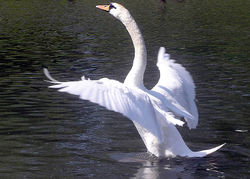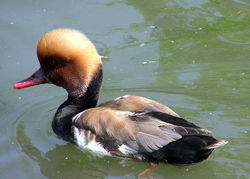| Ducks | ||||||||||
|---|---|---|---|---|---|---|---|---|---|---|

White-fronted Goose (Anser albifrons)
|
||||||||||
| Scientific classification | ||||||||||
|
||||||||||
|
Dendrocygninae Thalassorninae Anserinae Stictonettinae Plectropterinae Tadorninae Anatinae Merginae Oxyurinae |
Anatidae is the biological family that includes the ducks and most duck-like waterfowl, such as geese and swan. The Magpie-goose is no longer considered to be part of the Anatidae, but is placed in its own family Anseranatidae. These are birds that are modified for swimming, floating on the water surface, and in some cases diving in at least shallow water.
They have webbed feet and bills which are flattened to a greater or lesser extent. Their feathers are excellent at shedding water due to special oils. Anatidae are remarkable for being one of the few families of birds that possess a penis; they are adapted for copulation on the water only and care must be taken when breeding ducks or geese that a pool is provided for this purpose as attempts to copulate on dry land will often lead to injury of the drake's penis. Duck, eider and goose feathers and down have long been popular for bedspreads, pillows, sleeping bags and coats. The members of this family also have long been used for food.
While the status of the Anatidae as a family is straightforward, and there is little debate about which species properly belong to it, the relationships of the different tribes and subfamilies within it are poorly understood. The listing in the box at right should be regarded simply one of several possible ways of organising the many species within the Anatidae.
Classification
Previously divided into six subfamilies, recent anatomical studies by Livezey (1986; A phylogenetic analysis of recent Anseriform genera, Auk 103: 737-754) showed that the Anatidae are better treated in nine subfamilies. This classification has been followed by Madge & Burn:
Dendrocygninae: whistling ducks
- One pantropical genus, of distinctive long-legged
goose-like birds:
- Dendrocygna (whistling ducks, 9 species)
Thalassorninae: White-backed Duck
- One genus in Africa, most closely related to the
subfamily Dendrocygninae, though also showing convergent
similarities to the subfamily Oxyurinae:
- Thalassornis (White-backed Duck, 1 species)

Anserinae: swans and geese
- Five to seven extant genera with 27 living species,
mainly cool temperate Northern Hemisphere but also some
Southern Hemisphere species, with the
swans in two genera (three genera in some
treatments), and the
geese in four genera (three genera in some
treatments):
- Coscoroba (Coscoroba Swan, 1 species)
Cygnus (swans, 7 species, 4 sometimes separated in Olor)
Sarcidiornis (Mascarene Swan, extinct[1]).
Anser (grey geese, 7 species) - Chen (white geese, 3 species)
- Branta (black geese, 8 living species)
- Cereopsis (Cape Barren Goose, 1 species,
sometimes transferred to Tadorninae)
Cnemiornis (New Zealand Geese, extinct)
- Coscoroba (Coscoroba Swan, 1 species)
Stictonettinae: Freckled Duck
- One genus in Australia, formerly included in the
Oxyurinae, but with anatomy suggesting a distinct
ancient lineage perhaps closest to the Anserinae:
- Stictonetta (Freckled Duck, 1 species)
Plectropterinae: Spur-winged Goose
- One genus in Africa, formerly included in the
'perching ducks', but closer to the Tadorninae:
- Plectropterus (Spur-winged Goose, 1 species)

Tadorninae: shelducks, sheldgeese and steamer-ducks
- This group of larger, often semi-terrestrial
waterfowl can be seen as intermediate between Anserinae
and Anatinae. Recent revision has resulted in the
inclusion of 10 extant genera with 23 living species
(one probably extinct) in this subfamily, mostly from
the Southern Hemisphere but a few in the Northern
Hemisphere:
- Sarkidiornis (Comb Duck, 1 species)
Pachyanas (Chatham Island Duck, extinct)
Tadorna (shelducks, 7 species, one probably extinct)
Malacorhynchus (Pink-eared Ducks, 1 living species)
Centrornis (Madagascar Sheldgoose, extinct)
Alopochen (Egyptian Goose and Mascarene Shelducks, 1 living species)
Neochen (Orinoco Goose, 1 species)
Chloephaga (sheldgeese, 5 species)
Cyanochen (Blue-winged Goose, 1 species)
Hymenolaimus (Blue Duck, 1 species)
Merganetta (Torrent Duck, 1 species)
Tachyeres (steamer ducks, 4 species)
- Sarkidiornis (Comb Duck, 1 species)
Anatinae: dabbling and diving ducks and moa-nalos

- The
dabbling duck group, of worldwide distribution, were
previously restricted to just one or two genera, but has
now been extended to include 8 extant genera and about
55 living species, including several genera formerly
known as the "perching ducks":
- Pteronetta (Hartlaub's Duck, 1 species)
Cairina (Muscovy Duck and White-winged Wood Duck, 2 species)
Aix (Mandarin Duck and Wood Duck, 2 species)
Nettapus (pygmy geese, 3 species)
Anas (wigeons, gadwalls, teals, pintails, mallards, shovelers, etc, 40-45 living species)
Callonetta (Ringed Teal, 1 species)
Chenonetta (Maned Duck, 1 living species)
Amazonetta (Brazilian Duck, 1 species)
- Pteronetta (Hartlaub's Duck, 1 species)
- The moa-nalos, of which 4 species in 3 genera are
known to date, are a peculiar group of flightless,
extinct Anatidae from the Hawaiian Islands. Gigantic in
size and with massive bills, they were believed to be
geese, but have been shown to be in reality very closely
related to the genus Anas. They evolved to fill the
ecological niche of turtles, ungulates and other
megaherbivores.
- Chelychelynechen (Turtle-jawed Moa-nalo,
extinct)
Thambetochen (Large-billed Moa-nalos, 2 species, extinct)
Ptaiochen (Small-billed Moa-nalo, extinct)
- Chelychelynechen (Turtle-jawed Moa-nalo,
extinct)
- The 16 species of diving ducks, of worldwide
distribution, in 3 genera; Marmaronetta was formerly
included with the dabbling ducks but is now treated
here, and phylogenetic analysis of the probably extinct
Pink-headed Duck of India, previously treated
separately in Rhodonessa, has shown that it is
possibly better placed in Netta:
- Marmaronetta (Marbled Duck, 1 species)
Netta (Red-crested Pochard and allies, 4 species, one probably extinct)
Aythya (pochards, scaups, etc, 12 species, one probably extinct)
- Marmaronetta (Marbled Duck, 1 species)

Merginae: eiders, scoters, sawbills and other sea-ducks
- There are 10 extant genera and 20 living species
(one or two extinct); most of this group occur in the
Northern Hemisphere, but two Mergus in the
Southern Hemisphere:
- Chendytes (Diving-geese, extinct)
Polysticta (Steller's Eider, 1 species)
Somateria (eiders, 3 species)
Histrionicus (Harlequin Duck, 1 species)
Camptorhynchus (Labrador Duck, extinct)
Melanitta (scoters, 3 species)
Clangula (Long-tailed Duck, 1 species)
Bucephala (goldeneyes, 3 species)
Mergellus (Smew, 1 species)
Lophodytes (Hooded Merganser, 1 species)
Mergus (mergansers, 5 species, one extinct).
- Chendytes (Diving-geese, extinct)
Oxyurinae: stiff-tail ducks
- A small group of 4 genera, 3 of them monotypic, with
8 living species:
- Oxyura (stiff-tailed ducks, 5 living species)
Nomonyx (Masked Duck, 1 living species)
Biziura (Musk Ducks, 1 living species)
Heteronetta (Black-headed Duck, 1 species)
- Oxyura (stiff-tailed ducks, 5 living species)
References
- Madge and Burn, Wildfowl 1998 ISBN 0-7470-2201-1
External links
- Anatidae videos on the Internet Bird Collection




 216.73.216.91
216.73.216.91 User Stats:
User Stats:
 Today: 0
Today: 0 Yesterday: 0
Yesterday: 0 This Month: 0
This Month: 0 This Year: 0
This Year: 0 Total Users: 117
Total Users: 117 New Members:
New Members:
 216.73.xxx.xx
216.73.xxx.xx
 Server Time:
Server Time: